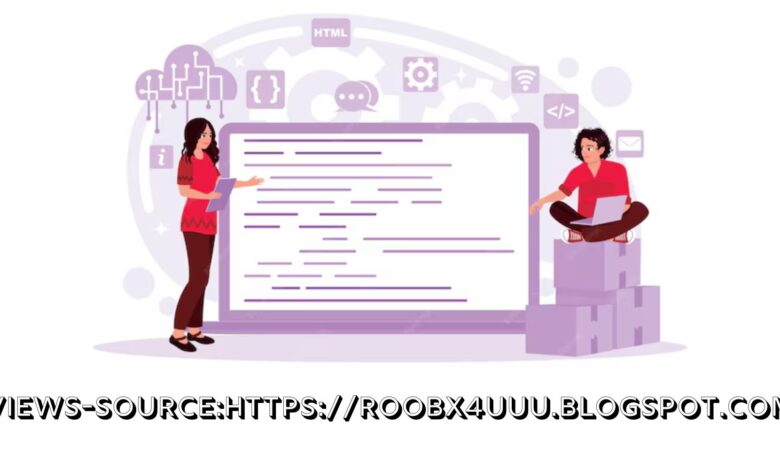views-source:https://roobx4uuu.blogspot.com: Understanding Source Code

In today’s digital landscape, where websites serve as the backbone of information dissemination, marketing, and business operations, understanding how websites function behind the scenes is an invaluable skill. Whether you are a web developer, content creator, or digital marketer, understanding the basic elements that make up a website can give you an edge in the online world. One of the key methods to access this information is through viewing the source code of a website.
This article delves into the keyword “views-source:https://roobx4uuu.blogspot.com”, exploring what it means, how it works, and why it is essential for those involved in web development, SEO, and digital marketing. We will break down the elements of source code, such as HTML, CSS, and JavaScript, and explain their roles in website creation. Additionally, we will discuss how understanding source code can benefit various professionals and enthusiasts in the digital space.
What Does “views-source:https://roobx4uuu.blogspot.com” Mean?
The phrase “views-source:https://roobx4uuu.blogspot.com” might appear cryptic at first glance, but it holds great significance, especially for those who work in web development and digital technology. The term “view-source” is a command in web browsers that allows users to see the underlying code that powers a webpage. By typing “view-source:” before the URL of a site (in this case, “https://roobx4uuu.blogspot.com”), you can view the raw HTML, CSS, and JavaScript that construct the visual content you interact with on your screen.
This view-source feature is supported by most modern browsers, including Chrome, Firefox, and Edge, and it acts as a window into the inner workings of the site. Whether you want to examine the structure, style, or functionality of a website, viewing its source code is the first step to gaining deeper insight into how web pages are built.
The Importance of Viewing Source Code
The source code of a website reveals the blueprint that guides how a page appears and behaves. Viewing this code offers several benefits, including understanding the design, interactivity, and structure of a site. For professionals like developers, designers, and marketers, being able to interpret and analyze the source code can provide a significant advantage.
1. Learning Web Development
For anyone starting in web development, examining the source code of established websites is an effective way to learn. By reviewing real-world examples of HTML, CSS, and JavaScript, beginners can see how these languages work together to form the websites they visit daily.
2. Web Design Insights
Designers can analyze the CSS (Cascading Style Sheets) in the source code to understand how websites are visually styled. By observing how color schemes, fonts, layouts, and visual elements are coded, designers can take inspiration and apply these principles to their projects.
3. Debugging and Troubleshooting
For developers, viewing the source code is crucial for debugging and troubleshooting. If a website isn’t functioning as expected, analyzing the source code helps pinpoint issues in the HTML, CSS, or JavaScript that could be causing malfunctions.
4. SEO and Digital Marketing
For digital marketers and SEO experts, the source code contains valuable insights into how content is structured for search engine optimization. Meta tags, alt texts, headers, and structured data found in the source code can offer information on how to optimize content for better rankings on search engines like Google.
Read More: 1-213-720-6488: Understanding the Significance of an Area Code
Key Components of Website Source Code
When you access the source code of a webpage using the “view-source” command, you’ll encounter three primary languages: HTML, CSS, and JavaScript. These three elements work in unison to form a fully functional website.
1. HTML: The Structure of a Webpage
HTML (Hypertext Markup Language) is the foundation of any website. It determines the structure and the content displayed on a webpage. HTML consists of various tags such as:
- <div>: Defines a division or section in a webpage.
- <h1>: Marks the first header and is usually the title of the webpage.
- <p>: Represents a paragraph of text.
- <a>: Defines hyperlinks to other web pages or files.
HTML is essential because it forms the skeleton of the site. Without it, there would be no visible content on the web page, only a blank screen. Viewing the source code reveals how these HTML elements are arranged to display text, images, and links.
2. CSS: The Style of a Webpage
CSS (Cascading Style Sheets) is responsible for the visual aesthetics of a webpage. While HTML defines the structure, CSS brings it to life by controlling the look and feel. CSS handles attributes such as:
- Colors
- Fonts
- Layout and positioning
- Spacing between elements
- Borders and backgrounds
The style of any website is defined through CSS, making it an essential tool for web designers. By viewing the source code, you can see how CSS is used to create a cohesive and visually pleasing interface. When accessing “views-source:https://roobx4uuu.blogspot.com”, for example, you’ll observe how CSS defines the appearance of each element.
3. JavaScript: The Interactivity of a Webpage
JavaScript is what makes websites dynamic and interactive. Without JavaScript, a website would be static, unable to perform actions such as:
- Validating forms (ensuring that the user has filled out all required fields).
- Animations (creating movement, such as buttons growing when hovered over).
- Loading content dynamically (without refreshing the page).
When exploring the source code of a website, JavaScript functions are often visible in snippets, revealing how the developers have added interactive features. Examining these scripts can be helpful for those learning to code dynamic features into their own websites.
How to View the Source Code of a Website
Viewing the source code of a website is straightforward and can be done through any major browser. Follow these steps:
- Open a Web Browser – Choose any browser, such as Chrome, Firefox, or Edge.
- Type “view-source:” Before the URL – In the address bar, prepend “view-source:” to the URL of the website you wish to examine. For example:
views-source:https://roobx4uuu.blogspot.com. - Press Enter – Your browser will display the website’s raw HTML, CSS, and JavaScript in a new tab.
Alternative Method
Most browsers also allow you to right-click on a webpage and select “View Page Source” from the context menu. This will display the source code of the current page.
Why Is Viewing Source Code Valuable?
The ability to view a webpage’s source code is invaluable for various reasons, making it an essential skill for web developers, designers, and digital marketers.
1. Learning and Inspiration
Viewing the source code offers an excellent way to learn from other websites. If you see a design or feature you like on a site, you can inspect the code to understand how it was implemented.
2. Checking for Errors
For web developers, debugging is a critical aspect of ensuring a site’s functionality. Source code reveals errors or issues that may not be visible in the front-end view of a site, allowing for quicker troubleshooting.
3. Improving SEO
For those involved in SEO, viewing the source code helps analyze how a site is optimized. By examining metadata, alt tags, and header tags, SEO professionals can gain insights into how the site ranks on search engines.
4. Ensuring Compliance
Some industries have strict compliance requirements for web development, particularly regarding data privacy and security. Viewing the source code ensures that essential elements like secure protocols, encryption, and compliance tags are implemented.
Conclusion
The phrase “views-source:https://roobx4uuu.blogspot.com” opens the door to understanding the technical inner workings of any website. Whether you’re a seasoned web developer, a digital marketer, or simply a curious internet user, exploring the source code of websites offers significant insights into how websites function. From learning web development skills to improving SEO strategy, viewing the source code is a simple yet powerful tool for anyone involved in the digital space.
FAQs
What is “view-source”?
View-source” is a command used in web browsers that allows users to see the underlying HTML, CSS, and JavaScript of a webpage. It helps users understand how a webpage is constructed.
Can I edit the source code I see?
While you can view and copy the source code, you cannot directly edit the source code of someone else’s website unless you have backend access to their server.
What is the benefit of viewing source code?
Viewing source code helps web developers, designers, and SEO experts learn how websites are built, identify errors, and improve site performance.
Which browsers support the “view-source” command?
Most major browsers, including Google Chrome, Firefox, Microsoft Edge, and Safari, support the “view-source” command.
Can I learn web development by viewing source code?
Yes, viewing the source code of websites is a great way to learn how HTML, CSS, and JavaScript work in real-world examples, making it a helpful tool for aspiring web developers.



